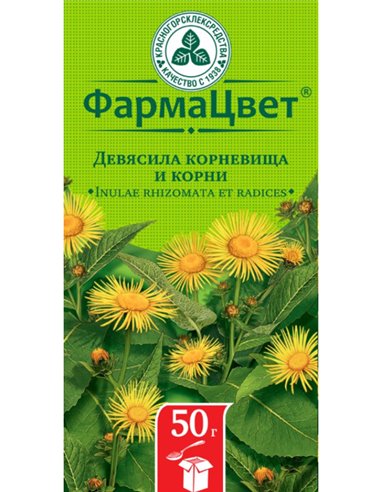Your cart
There are no more items in your cart
Elecampane - a plant that is widely used in medicine. An infusion of its roots and rhizomes is prescribed when coughing as an expectorant. Thanks to a combination of inulin, mucus, essential oil and other biologically active substances, infusion of elecampane contributes to a better sputum discharge in case of bronchitis, tracheitis and other diseases of the upper respiratory tract, accompanied by cough.
Ingredients: contains an essential oil consisting of a mixture of sesquiterpene lactones (alantholactone, isoalantholactone, etc.); bitter glycoside alantopicrin; inulin
Pharmacological action: stimulates the general metabolism in the body. It has a pronounced anti-inflammatory, antimicrobial, fungicidal, antiseptic, antihelminthic, immunomodulatory and anti-allergic effect. It has a diaphoretic, diuretic, choleretic and astringent.
In Tibetan medicine, the above-ground part of the plant is recommended for quinsy, diphtheria, and gastrointestinal diseases. Inflorescences of elecampane are used in pneumonia, as a hemostatic and healing agent, they are part of the complex medicinal mixtures necessary for coughing, rheumatism, atherosclerosis, gout, neurasthenia.
In India, Ninety is used for chronic bronchitis and rheumatism.
In China, the inflorescences of Deviacela are used as an expectorant and antiseptic for purulent wounds.
In Mongolia, inflorescences of elecampane are used in polyarthritis and as an antiscorbetic agent. They are part of a complex mixture used for headaches, disorders of cerebral circulation. Leaves and inflorescences devyaatsila use with peritonitis, anthrax and wounds.
In Bulgaria, spirit infusion of the root of elecampus is recommended for palpitations, headaches, epilepsy, whooping cough, etc.
In Russia, the rhizome of devayasila is taken for asphyxiation, bronchitis, whooping cough, and also as an expectorant, anthelmintic, hemostatic, diuretic and appetite-enhancing agent. Outwardly - with eczema, neurodermatitis, scabies and other skin diseases.
In Kyrgyzstan, virgin is used for gastric and duodenal ulcers as an anthelmintic agent.
The rhizomes of elecampane are also used as a spice in the confectionery industry (a substitute for ginger) and in the alcoholic beverage industry for flavoring vermouth and liqueurs.
The name of the elecampus is derived from the inula - the Latin name of the plant and the Greek helios - “sun”, which is associated with the form of the inflorescence of the elecampane.
Ingredients: contains an essential oil consisting of a mixture of sesquiterpene lactones (alantholactone, isoalantholactone, etc.); bitter glycoside alantopicrin; inulin
Pharmacological action: stimulates the general metabolism in the body. It has a pronounced anti-inflammatory, antimicrobial, fungicidal, antiseptic, antihelminthic, immunomodulatory and anti-allergic effect. It has a diaphoretic, diuretic, choleretic and astringent.
In Tibetan medicine, the above-ground part of the plant is recommended for quinsy, diphtheria, and gastrointestinal diseases. Inflorescences of elecampane are used in pneumonia, as a hemostatic and healing agent, they are part of the complex medicinal mixtures necessary for coughing, rheumatism, atherosclerosis, gout, neurasthenia.
In India, Ninety is used for chronic bronchitis and rheumatism.
In China, the inflorescences of Deviacela are used as an expectorant and antiseptic for purulent wounds.
In Mongolia, inflorescences of elecampane are used in polyarthritis and as an antiscorbetic agent. They are part of a complex mixture used for headaches, disorders of cerebral circulation. Leaves and inflorescences devyaatsila use with peritonitis, anthrax and wounds.
In Bulgaria, spirit infusion of the root of elecampus is recommended for palpitations, headaches, epilepsy, whooping cough, etc.
In Russia, the rhizome of devayasila is taken for asphyxiation, bronchitis, whooping cough, and also as an expectorant, anthelmintic, hemostatic, diuretic and appetite-enhancing agent. Outwardly - with eczema, neurodermatitis, scabies and other skin diseases.
In Kyrgyzstan, virgin is used for gastric and duodenal ulcers as an anthelmintic agent.
The rhizomes of elecampane are also used as a spice in the confectionery industry (a substitute for ginger) and in the alcoholic beverage industry for flavoring vermouth and liqueurs.
The name of the elecampus is derived from the inula - the Latin name of the plant and the Greek helios - “sun”, which is associated with the form of the inflorescence of the elecampane.
4601498006794

